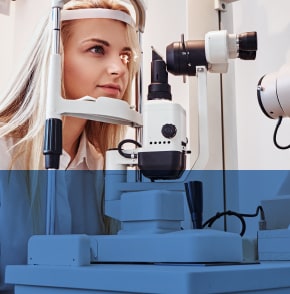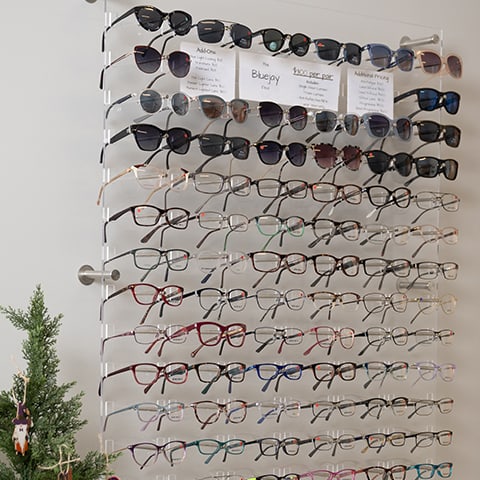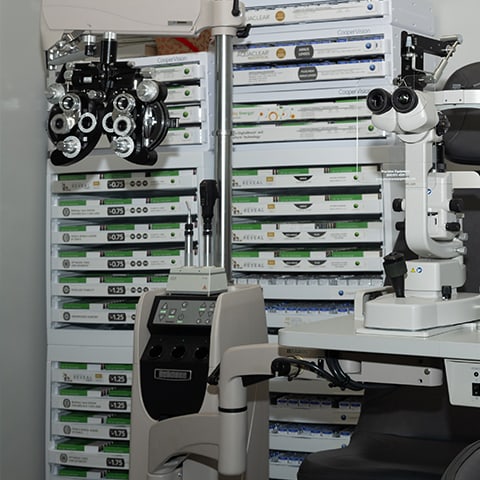We’re Here to Help Protect Your Vision
A routine eye exam is the first line of defense against vision loss. Many eye diseases, like glaucoma and macular degeneration, can develop and progress without symptoms, often causing significant damage before being detected. At Prairie Vision Center, we offer personalized care for a wide range of eye conditions, from common infections to more complex diseases.
Dr. Korth has years of experience and completed a residency at the Lexington, KY, VAMC in primary eye care focused on low vision and ocular disease. Her training allows her to deliver personalized, comprehensive care for your eye health.
Infections, Irritations, Diseases & Conditions
Your eye health matters to us, whether you’re here for minor irritation or ongoing management of a chronic condition. If you have an eye infection, we’ll carefully examine and treat what’s causing your discomfort. Dr. Korth will sit with you to answer questions and ensure you feel informed and supported.
Many eye conditions, such as cataracts, glaucoma, macular degeneration, and diabetic retinopathy, have little to no symptoms when they’re first able to be diagnosed. Routine eye exams are critical to catching these conditions before they cause damage.
Glaucoma
Glaucoma is a group of eye diseases that damage the optic nerve and can lead to permanent vision loss. There are several types of glaucoma, many of which progress with no noticeable symptoms. There are very few types of glaucoma that have any symptoms until your vision is in severe danger.
We screen every patient for glaucoma risk factors so we can detect them early and take steps to prevent vision loss.
Risk Factors include:
- High internal eye pressure
- Appearance of optic nerves
- Family history
- Age
- Previous eye injuries
- Cardiovascular diseases
Age-Related Macular Degeneration
Age-related macular degeneration (AMD) is a highly genetic type of blindness. If it runs in your family, you should have at minimum one eye exam a year to monitor for this. It can cause a loss of central vision making all detailed vision blurred.
There are 2 main types:
- Dry AMD is the more common form of the disease and occurs in early, intermediate, and late stages. This form of AMD occurs when the macula thins with age. When it reaches advanced stages, it is known for thinning and loss of the retina. There is currently no treatment recommended for this type of advanced AMD.
- Wet AMD is another form of late-stage AMD. It can cause fast and severe vision loss due to bleeding within the retina. It occurs when abnormal blood vessels grow in the wrong place and damage center of vision. This is the type most commonly treated by ophthalmologists with vision-saving injections.
Cataracts
Cataracts are a clouding of the eyes lens and can affect vision. Most cataracts are caused by the natural aging of the lens, but they can be present even at birth.
In the early stages, aging-related cataracts may have little impact on sight, but as they progress, they can cause increasingly blurred or dimmed vision. While early symptoms can often be managed with updated prescriptions or better lighting, cataract surgery may become necessary if vision loss interferes with daily activities. We’ll monitor any changes through regular eye exams and discuss options to keep your vision clear and comfortable.
Cataracts can progress quickly in some cases, so do not hesitate to schedule follow-ups prior to your annual eye exam.
Diabetic Retinopathy
Diabetes increases the risk of several eye conditions, including glaucoma, cataracts, and diabetic retinopathy. Diabetic retinopathy is the leading cause of new blindness in adults in the USA, and risks of it can be dramatically decreased with good control of your diabetes.
If you have diabetes, we’ll perform specialized tests during your exam to monitor changes in your eye health, paying close attention to early signs of diabetic retinopathy and other eye diseases.
We also communicate with your diabetes care team to share any early signs of blood vessel damage in your eyes. Since blood vessel damage isn’t limited to the eyes, but is often first visible there, regular eye exams can help detect issues early. The tiny blood vessels in your eyes are the smallest and easiest to observe, making them a crucial window into your overall health.
We Offer Dry Eye Management
Dry eye is a common ocular surface disease that affects millions of Americans. It causes symptoms like:
- Tired eyes
- Blurring that comes and goes
- Watery eyes
- A dry, gritty feeling
- Redness
- Stinging/burning sensation
- Decreased vision, especially at the end of a task
Using our dry eye technology, we can diagnose, treat, and provide long-term relief from your dry eye symptoms. Learn more about our dry eye services.
Helping You Manage Eye Disease
Eye disease can take many forms, and regular eye exams allow us to monitor changes in your eye health and vision over time. We’re committed to supporting your long-term visual health with personalized, attentive care.
Schedule an appointment with us today to take the next step in protecting your vision.
Request AppointmentCome Visit Us

Our Address
- 87 Paine St, Suite 3
- Bondurant, IA 50035
Contact Information
- Phone: 515-267-7908
- Text: 515-755-0080
- Email: [email protected]
Our Hours
Hours
- Monday: By Appointment Only
- Tuesday: 8:30 AM – 5:30 PM
- Wednesday: 8:30 AM – 5:30 PM
- Thursday: 8:30 AM – 5:30 PM
- Friday: 8:30 AM – 12:00 PM
- Saturday: Closed
- Sunday: Closed
Our Brands
Our Eyewear Options

